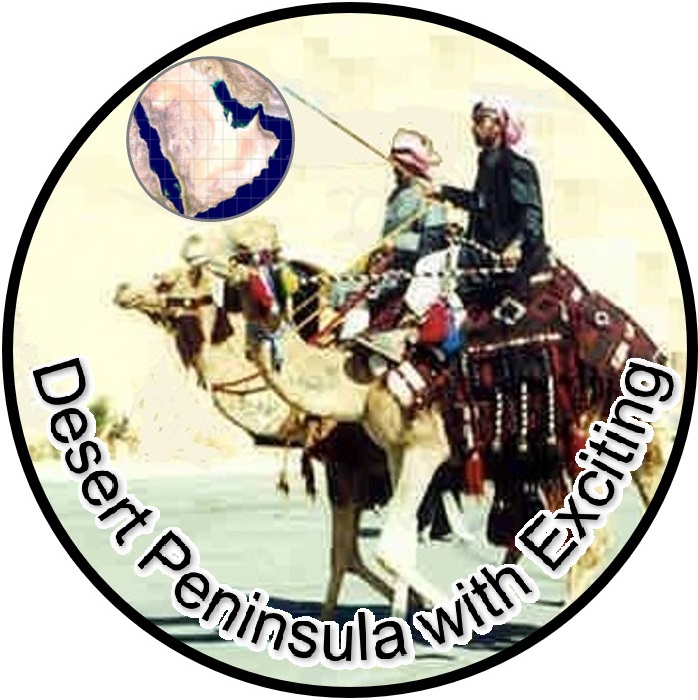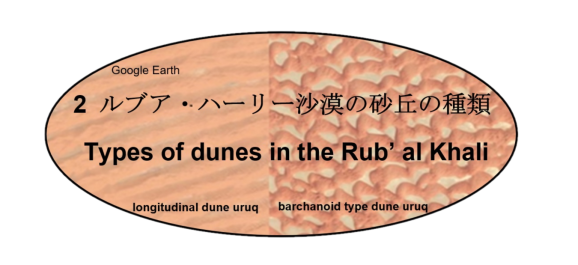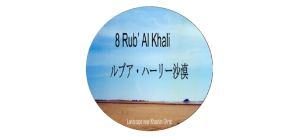Types of dunes in the Rub’ al Khali
縦砂丘
線形砂丘群
セイフ砂丘
ジバール砂丘(羽状砂丘)
シグモイド砂丘(S字状砂丘)
フィッシュフック砂丘(釣り針状砂丘)
発散砂丘(先別れ型砂丘)
線形砂丘複合体のピラミッド型砂丘群
横砂丘
メガバルハン砂丘
バルハン状砂丘の尾根
星型砂丘
ドーム型砂丘
Longitudinal dune
Linear dunes group
Seif dunes
Zibar (feather dunes)
Sigmoidal dunes
Fishhook dunes
Divergent dunes
Pyramidal dunes of linear dunes complex
Barchanoid type dune
Megabarchans
Barchanoid ridges
Star dunes
Dome dunes
前書き
Preface
現在のルブア・ハーリー沙漠が形成され始めての6,000年の間に、幾つかの異なる種類の砂丘が、それぞれの特徴ある形に作られてきました。
砂丘の種類は、砂の供給量、砂の粒径と組成、表面粗さ、速度、方向、風の持続時間と変動性、湿度、および地下と植生の性質によって異なります。 砂丘の蓄積は、障害物の存在または地面の起伏の変化のために、砂を積んだ風塊の中断によって発生すると考えられています。
ルブア・ハーリー沙漠の風成砂丘群も大別すれば、縦砂丘、横砂丘および星形砂丘に分けられます。縦砂丘には後述する様々な線形砂丘群があります。横砂丘は、本来はバルハン砂丘、バルハン型リッジと横列砂丘の3つのサブタイプに分かれます。
しかしながら、ルブア・ハーリー沙漠では巨大なメガバルハンが卓越して多く、一方で小さなバルハンも独立してあるいは副次的に良く発達しています。このため、横砂丘の分類としてはバルハン、メガバルハンおよびそれらが複合したバルハン型リッジとしました。
星形砂丘で高さが100~200メートルを超える大きなものはアーホードともピラミッド砂丘とも呼ばれます。この章ではピラミッド型砂丘と星形砂丘にドーム砂丘を合わせて、砂山砂丘と呼んでいます。
縦砂丘は、2方向の風で形成され、横砂丘は一方方向の風で形成されます。砂山砂丘は、風の方向が様々に変化するために、2つ以上の砂丘タイプの組み合わせで作られます。
ルブア・ハーリー沙漠の代表的で大部分は、ドラア級ウルーク(大規模な砂丘山嶺)で占められています。これらは、見かけの風の流れと平行(縦方向)に、長い尾根が何本もほぼ平行に配置されることもあれば、それと垂直(横方向)な山並みが大きな砂の波のように縦方向に幾重にも重なることもあります。
前者が縦砂丘である線形砂丘群で、ルブア・ハーリー沙漠中央東部から南西部に広く展開しています。後者が横砂丘であるメガバルハン砂嶺で、ルブア・ハーリー沙漠東部の大半を占めています。筆者は、メガバルハン砂嶺を作り出す東部地域の風向きにはハジャル山脈が大きく影響していると考えています。
砂山砂丘は、ルブア・ハーリー沙漠中央部南縁にドーム砂丘が見られ、ピラミッド型砂丘あるいは星形砂丘は、ルブア・ハーリー沙漠東南部に多く見られます。
なお、ドラア級ウルークとされる巨大な砂丘は、通常、より小さな二次砂丘パターンで覆わているため、複合砂丘とも呼ばれます。
During the 6,000 years since formation of the present Rub’ al Khali desert, several different types of dunes have been created in their respective distinctive shapes.
A type of dune depends on sand (supply, particle size, composition, surface roughness), wind (velocity, direction, duration and variability), humidity, underground nature and vegetation. A dune-buildup is caused by interruptions of sand-laden wind masses due to presence of obstacles or changes in ground undulations.
Aeolian dunes of the Rub ’al Khali desert can also be broadly divided into longitudinal dune, barchanoid type dune and star dune.
There are various linear dunes groups described below in longitudinal dunes. Barchanoid type dune is originally divided into three subtypes: barchan dune, barchanoid ridge and transverse dune.
However, in Rub’ al Khali, Giant megabarchans dominate, while smaller barchans are well developed a lot independently or secondarily. For this reason, barchanoid type dunes are classified to 3 which are barchan, megabarchan and barchanoid ridge (complex of the previous two) in this chapter.
Large star dunes with a height of over 100-200 meters are also called rhourd or pyramidal dunes. In this chapter, pyramidal dunes and star dunes are classified to sand mountains along with dome dunes.
Longitudinal dunes are formed by a two-way wind, while barchanoid type dune is formed by a one-way wind. Sand mountains are made up of a combination of two or more dunes due to various wind directions.
Typical and most of the Rub’ al Khali is occupied by large dune ridges (draa class uruqs). These have a number of long ridges arranged in longitudinal, almost parallel to prevailing wind direction. On the other hand, barchanoid ridges are horizontally formed perpendicular to prevailing wind direction, and they are overlapped in longitudinal direction like large sand waves.
The former is a linear dune group, which is a kind of longitudinal dunes, and is widely spread from the central-eastern Rub’ al Khali to the southwestern Rub’ al Khali.
The latter is megabarchan ridge, which occupy most of the eastern Rub ’al Khali and is a kind of barchanoid type dunes. The Hajar mountains might have a great influence on wind direction in the eastern Rub ’al Khali where megabarchan ridges are created.
In isolated dune massifs, or qa’aid, dome dunes are found on southern edge of the central Rub’ al Khali, and pyramidal dunes or star dunes are also found in the southeastern Rub’ al Khali.
Draa class uruqs as well as megabarchans are generally called compound dunes because they are usually covered with smaller secondary dune patterns.
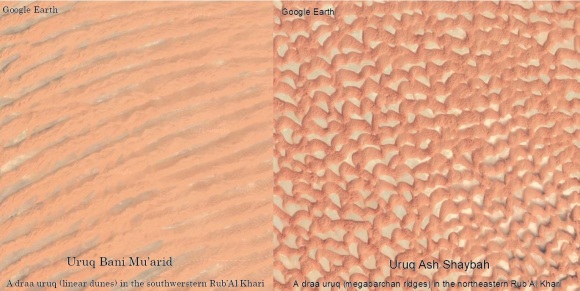
Uruq Bani Mu’arid: A draa uruq (linear dunes) in the southwestern Rub’ Al Khali
Draa class uruqs as well as megabarchans are generally called compound dunes because they are usually covered with smaller secondary dune patterns.
縦砂丘
Longitudinal dunes
線形砂丘群
ルブア・ハーリー沙漠で支配的なのが、線形砂丘群です。
ルブア・ハーリー沙漠での卓越風は、シャマールで、夏と冬の両方で発生します。それぞれ北西から南東および北東から南西に吹風ですが、カタール半島以南では、いずれも貿易風などに影響されて、西南西に転じてゆきます。シャマールは、5月下旬から7月上旬まで非常に持続的で強力です。もう1つの重要な風は、南西モンスーンの産物であるハーリフ(خارف)です。
これらの風によって、ルブア・ハーリー沙漠の中央東部から同沙漠の南西部を縁取るアラダ崖地および ハドラマウト・アーチへとほぼ平行に西南西へ延びる数百の線形砂丘の巨大なウルーク群が作り出されています。ルブア・ハーリー沙漠の南部および南西部の広い地域では、稜線間隔が平均2キロから最大6キロで、並行する長さは最大260~300キロ、平均150キロの線形砂丘のこれら巨大なウルーク群で覆われています。このような巨大なウルークは、巨大な砂丘を意味するドラアとも呼ばれおり、ルブア・ハーリー沙漠南西部で最大250〜300メートルの高さに達する可能性があります。また、このような線形型のドラア級ウルーク砂丘の上にバルハン砂丘が二次砂丘として形成されることは、ままあります。
線形型のドラア級ウルークは、この他にルブア・ハーリー沙漠最北東部(アラブア首長国連邦のアラビア湾とハジャール山脈の間)で、西北西から東南東へと発達しています。
ルブア・ハーリー沙漠で見られる線形砂丘群としては、この様なセイフ砂丘の他に、ジバール砂丘(羽状砂丘)、シグモイド砂丘(S字状砂丘)、フィッシュフック砂丘(釣り針状砂丘)やスモールリニア砂丘(小線形砂丘)、収束砂丘(先収束型砂丘)、発散砂丘(先別れ型砂丘)等の線形砂丘群があります。
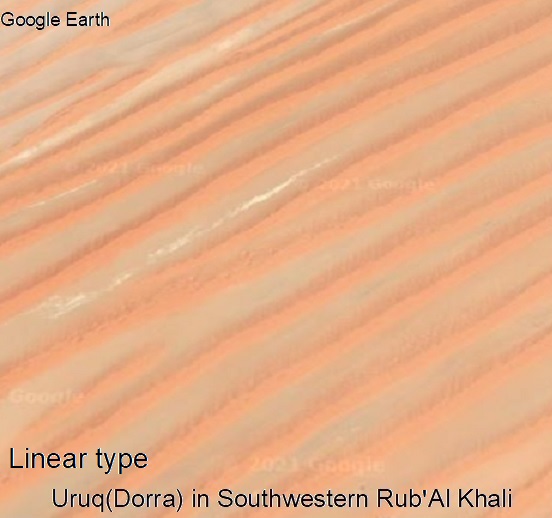
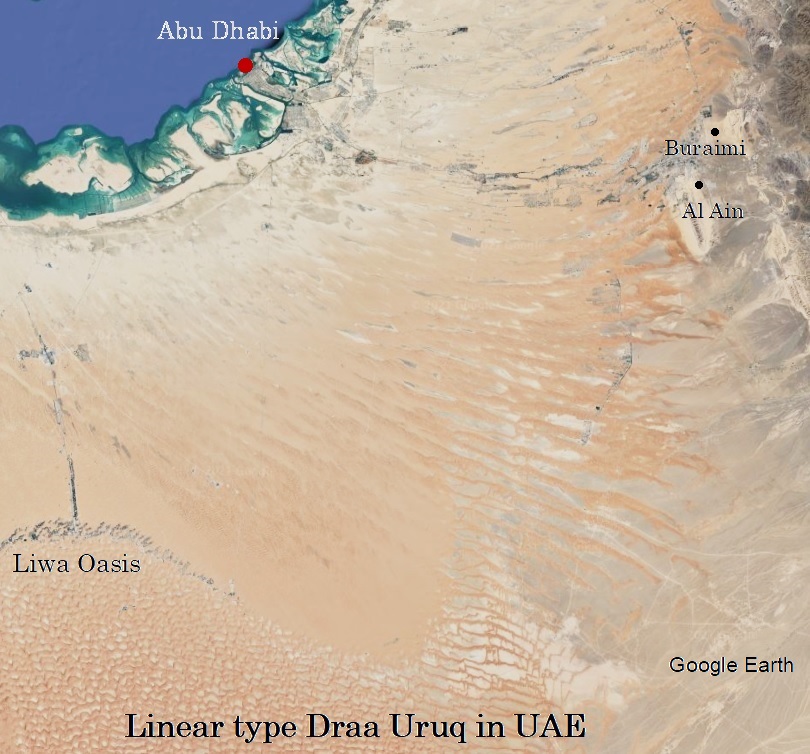
Linear dunes group
In the Rub’ al Khali, linear dunes group dominate and also occupy the largest area.
Prevailing winds in the Rub ’al Khali are shamals and they occur both in summer and in winter. Winds blow from northwest to southeast and from northeast to southwest, respectively, but in airspace south of the Qatar Peninsula, they all turn their direction to west-southwest getting influence of trade winds. Shamals are very persistent and powerful from late May to early July. Another important wind is kharif, a product of southwest monsoon.
These winds create hundreds of huge linear dunes extending west-southwest almost parallel to each other from the central eastern Rub’ al Khali. Those uruqs extend to the Aradh escarpment and/or the Hadramawt arch, which border the southwestern Rub’ al Khali. The large areas of the southern and southwestern Rub’ al Khali are covered by these giant uruqs of linear dunes with an average ridge spacing of 2 kilometers to 6 kilometers and parallel lengths of up to 260-300 kilometers with an average of 150 kilometers. Such a giant uruq, also known as draa, which means a huge dune, can have a height of up to 250-300 meters in the southwestern Rub’ al Khali. Also, it is still possible for barchan dune to form as secondary dunes on such linear type draa-class uruq dunes.
Linear type draa-class uruqs have also developed from west-northwest to east-southeast in the most northeastern Rub’ al Khali (between Arabian Gulf in the United Arab Emirates and the Hajar mountains ).
In addition to these seif dunes, linear dunes found in the Rub’ al Khali include seif dunes, zibar (feather dunes), sigmoidal dunes, fishhook dunes, small linear dunes, convergent dunes, and divergent dunes.
セイフ砂丘
ドラアよりも小さな線形砂丘は、セイフ砂丘と呼ばれ、ルブア・ハーリー沙漠中央部の大部分は、セイフ砂丘群で占められています。また、線形型ドラア砂丘帯でも、小さなセイフ砂丘が斜めに結合することがままあります。
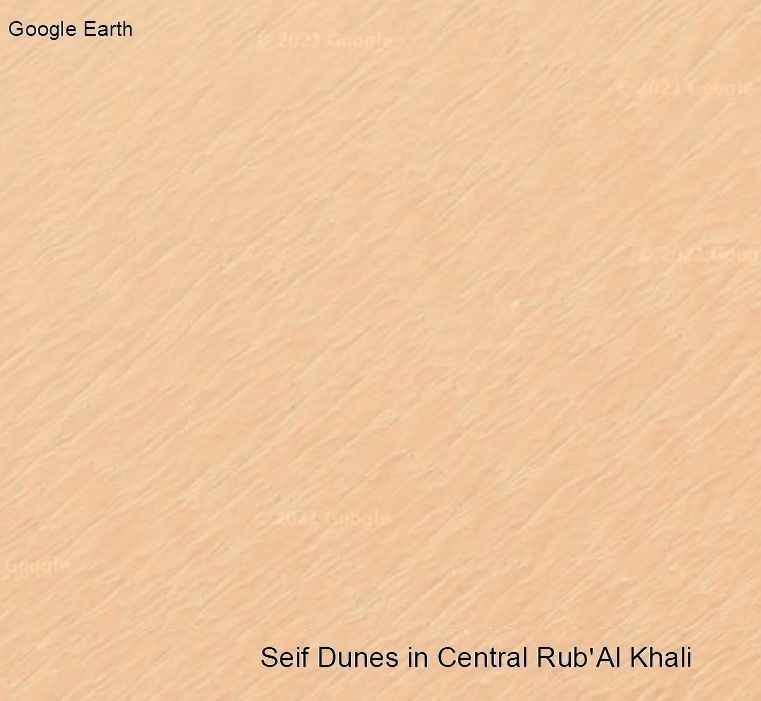
Seif dunes
Linear dunes smaller than draa are called seif dunes, and most of the central Rub’ al Khali is occupied by seif dunes. Also, in linear type draa dunes, small seif dunes often join diagonally.
ジバール砂丘
並行する砂丘間の風の速度が遅いと、砂丘間には滑り面がなく、しばしば三日月形の粗い砂の低い砂の尾根が形成されます。この尾根がジバール(زئبر)(毛羽立ち)です。ジバールは、ルブア・ハーリー沙漠の4分の3の砂丘間地域(shuqqan)で一般的に見られると言われています。スライルの東北東約280キロでは、風下に結合して単一の尾根を形成する多数の砂丘尾根からなるジバール砂丘(zibar)がみられると言われています。しかし、Google Mapではあまり明確ではありません。
ジバール砂丘の成り立ちが比較的明確に分かるのが、シュカーン (الشقان)地域の枝分かれした羽毛状の砂丘です。
シュクカン地域は、ハラド(حرض)南100キロにあるヤブリーン(يبرين)オアシスをさらに南に140〜250 キロ下った地域です。ここでは、画像上部に現われているように多数のわずかに発散する砂丘が、見られる他に小さなバルハン(三日月形の砂丘)が風下に行くに従って、幾つも合体して、枝分かれした羽毛状の砂丘になっています。この羽毛状の砂丘がさらに風下では狭まって、単一の線形砂丘の尾根に成っています。それぞれの砂丘の長さは、10〜60 キロ程度です。
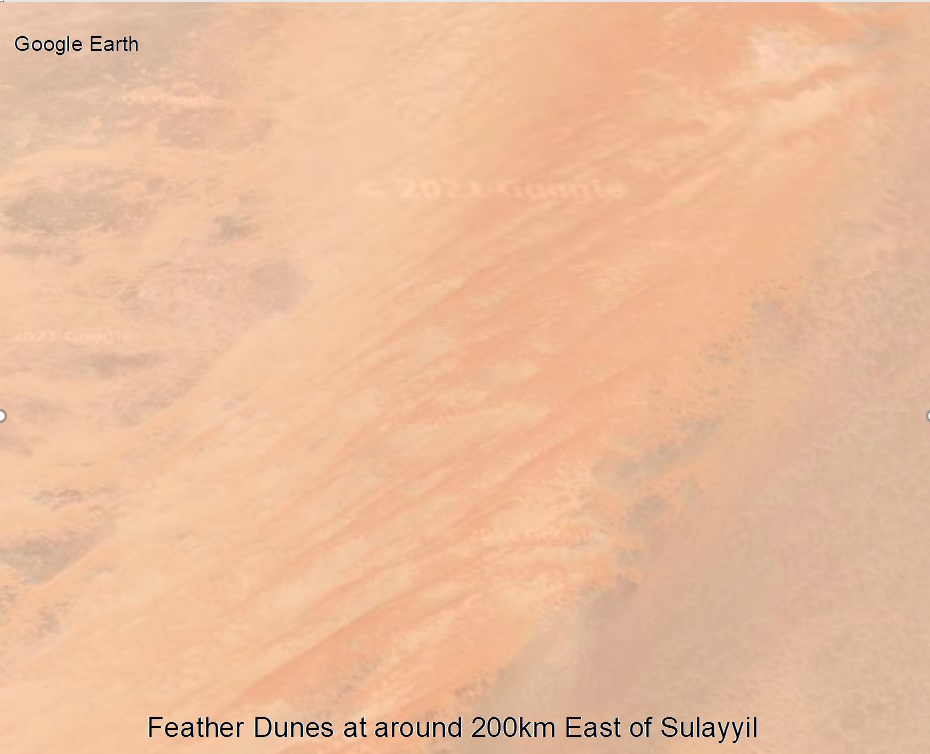
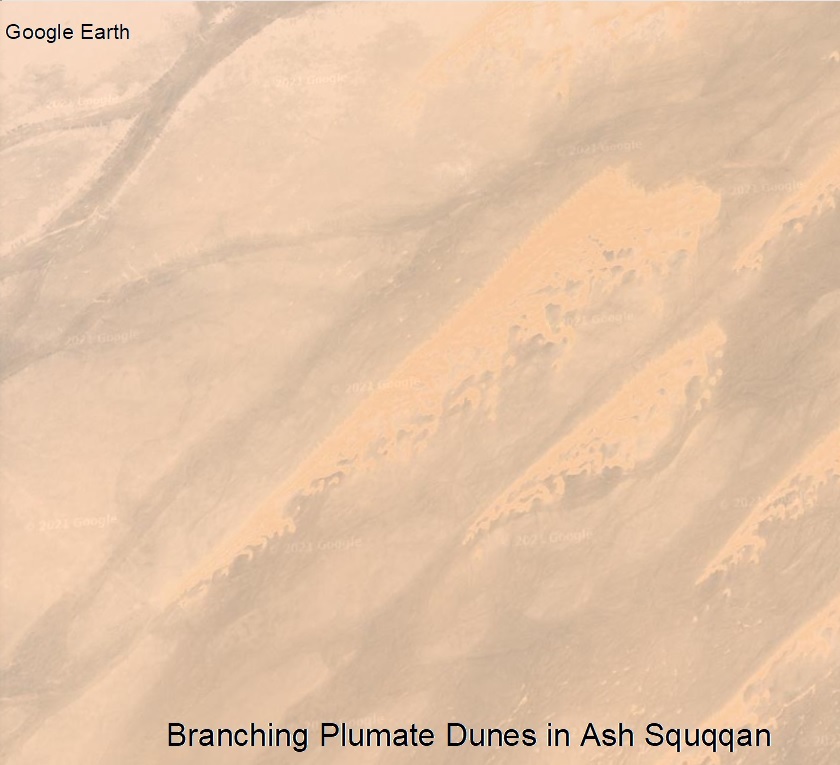
Zibar (feather dunes)
When wind velocity between parallel dunes is slow, there are no slip surfaces between dunes, often forming low sand ridges of crescent-shaped coarse sand. This ridge is zibar (زئبر) (fuzz, pile). Zibar is said to be commonly found in interdune areas of three-quarters of the Rub’ al Khali. Approximately 280 kilometers east-northeast of Sulayyil, it is said that a zibar consisting of numerous dune ridges that combine leeward to form a single ridge can be seen. But it’s not very clear on Google Maps.
Ash Sguqqan is 140-250 kilometers south of Yabrin Oasis, where is 100 south of Haradh. At Ash Sguqqan, together with a number of slightly divergent dunes, as shown at top of image, many of smaller barchan dunes (crescent dunes) merge each other along with going downwind. Then, they become a branched, feather-shaped dune. This feather-like dune narrows further downwind, forming a single linear dune ridge, whose length are about 10-60 kilometers.
シグモイド砂丘
S字状砂丘砂丘とも言われ、ςあるいはS字型をした砂丘です。風向が多少変動し、風がその長さに対して斜めに交互になっている場合に形成され、ルブア・ハーリー沙漠南西部に見られるといいます。図はウルーク・ムンダファンにおけるシグモイド砂丘です
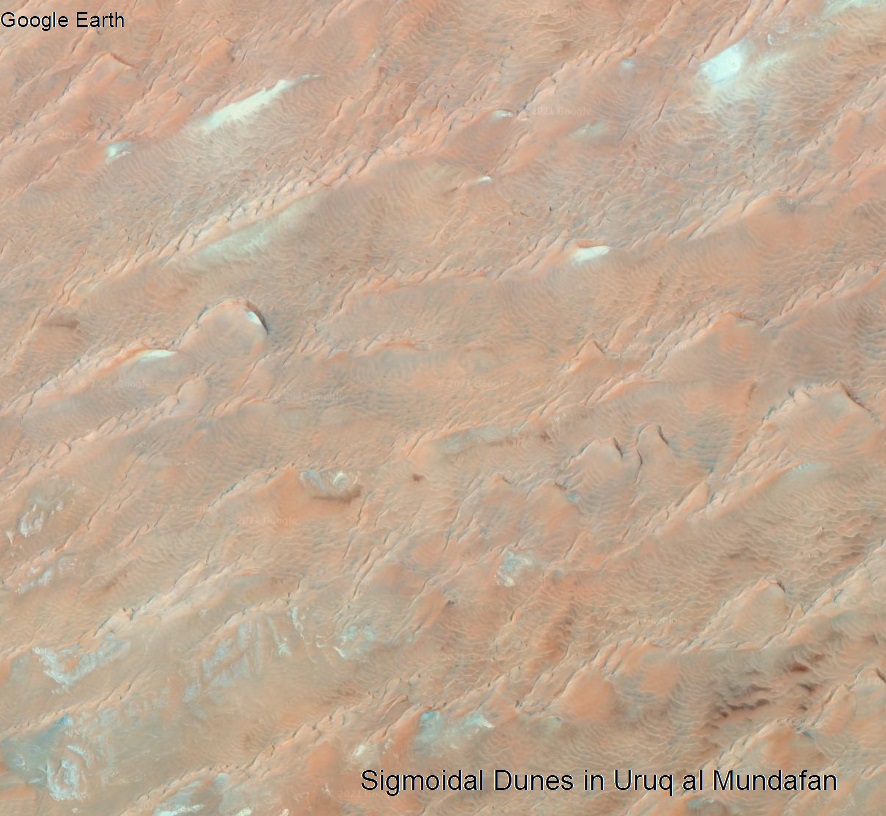
Sigmoidal dunes
S-shaped dunes is also known as ς -shaped dunes. It is formed when wind direction fluctuates slightly and winds alternate diagonally with respect to its length, and is found in the southwestern Rub’ al Khali. Figure is a sigmoidal dune in the Uruq al Mundafan.
発散砂丘
図に示すムラト・アル・クサイイイブの様に1つの線形砂丘が北東に2つまたは3つの砂丘の尾根に分岐しています。
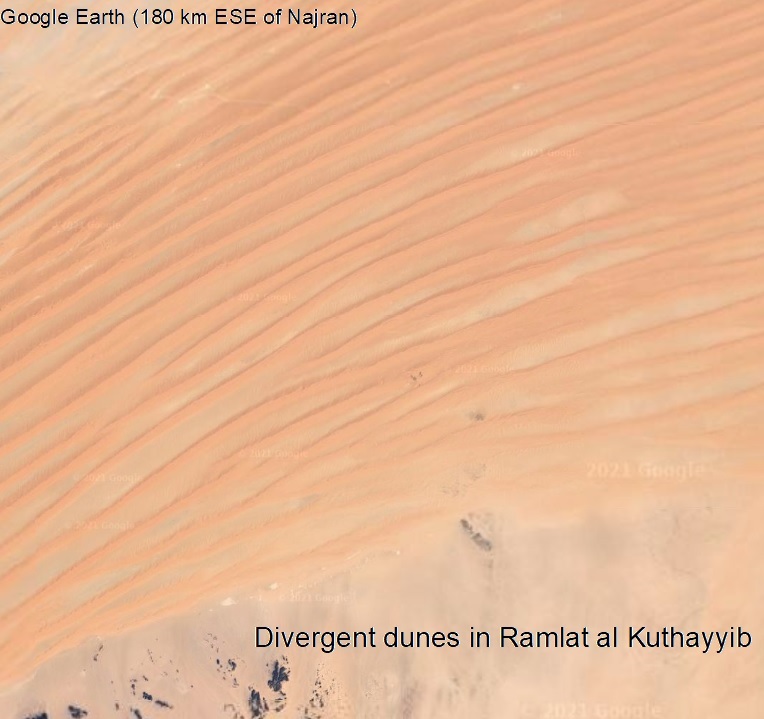
Divergent dunes
One linear dune branches northeast into two or three dune ridges, as shown in figure of the Ramlat al Kuthayyib.
フィッシュフック砂丘
ルブア・ハーリー沙漠中南部の広い地域でよく見られる線形砂丘の一種は、釣り針砂丘です。 多くの場合、別々の三日月形の砂丘と線形の砂丘として始まります。その後、合体して特徴的な釣り針の形になり、長くて直線的な尾根を構成します。見かけの横方向の起源の末端の三日月形の北東端でシャフトを形成しています。1つまたは複数の三日月形の部分は、最大数メートルの高さの滑り面を持ちます。

Fishhook dunes
A type of linear dunes commonly found in large areas of the south-central Rub’ al Khali is fishhook dunes. It often begins as separate crescent-shaped dunes and linear dunes. It then coalesces into a characteristic hook shape, forming a long, straight ridge. A shaft is formed at northeastern end of crescent shape at end of apparent lateral origin. One or more crescent-shaped parts have a sliding surface with a height of up to several meters.
線形砂丘複合体のピラミッド型砂丘群
別のタイプの線形砂丘複合体としては、ラムラト・ミーターンで見られるピラミッド型砂丘の整列した帯です。
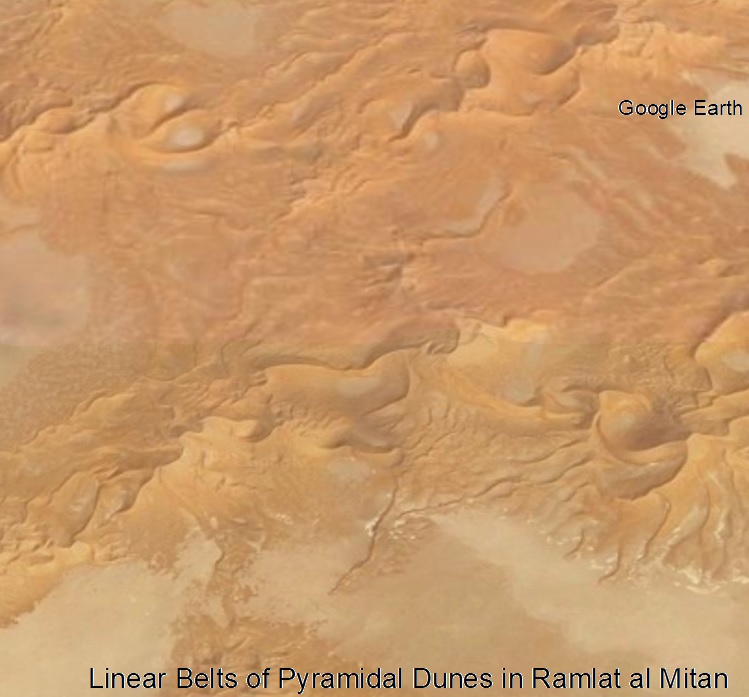
Pyramidal dunes of linear dunes complex
Another type of linear dune complex is pyramidal dunes linear belts found in the Ramlat al Mitan.
横砂丘
Barchanoid type dune
メガバルハン砂丘
ルブア・ハーリー沙漠で最も高く大きな砂丘は、巨大な三日月形の砂丘であるメガバルハン砂丘です。高さ230メートルにも達するメガバルハン砂丘は、約38,000平方キロメートルまたは沙漠の6%を占めます。しかし、その大部分は、ウルーク・ムウタリダとウルーク・シャイバーに集中しています。それらは、南側または南東側に巨大なすべり面を持つ巨大な三日月形を取り、通常、長さは2〜4キロです。メガバルハンの風上を向いた側には、巨大縦砂丘ウルクと同様に、多くの小さなバルハン砂丘やシグモイド砂丘等の二次砂丘が形成されます。
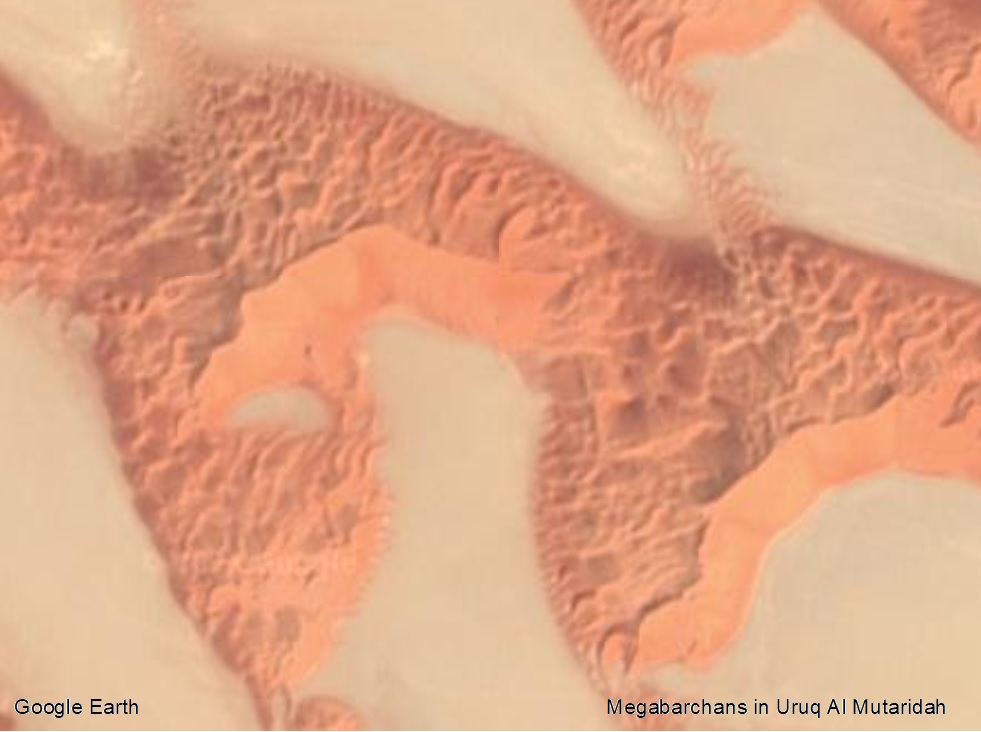
Megabarchans
The tallest and largest dunes in the Rub ’al Khali are megabarchans, which are huge crescent-shaped dunes. Megabarchans, which reach over 230 meters in height, occupy about 38,000 square kilometers or 6% area of the Rub ’al Khali. But most of them concentrate in the Uruq al Mutaridah and the Uruq ash Shaybah. They take a huge crescent shape with a huge slip surface on south or southeast side, usually 2~4 kilometers in length. On windward side of megabarchans, many small secondary dunes such as barchan dunes, sigmoidal dunes etc. are formed like as it is occurs on a huge linear dune.
バルハン状砂丘の尾根
バルハンとメガバルハンは、横方向に結合してバルハン状砂丘の尾根を形成することができます。これらは、アラブ首長国連邦南部のリーワー地域(ليوا))特に多く見られ、少なくとも70の砂丘の尾根があります。
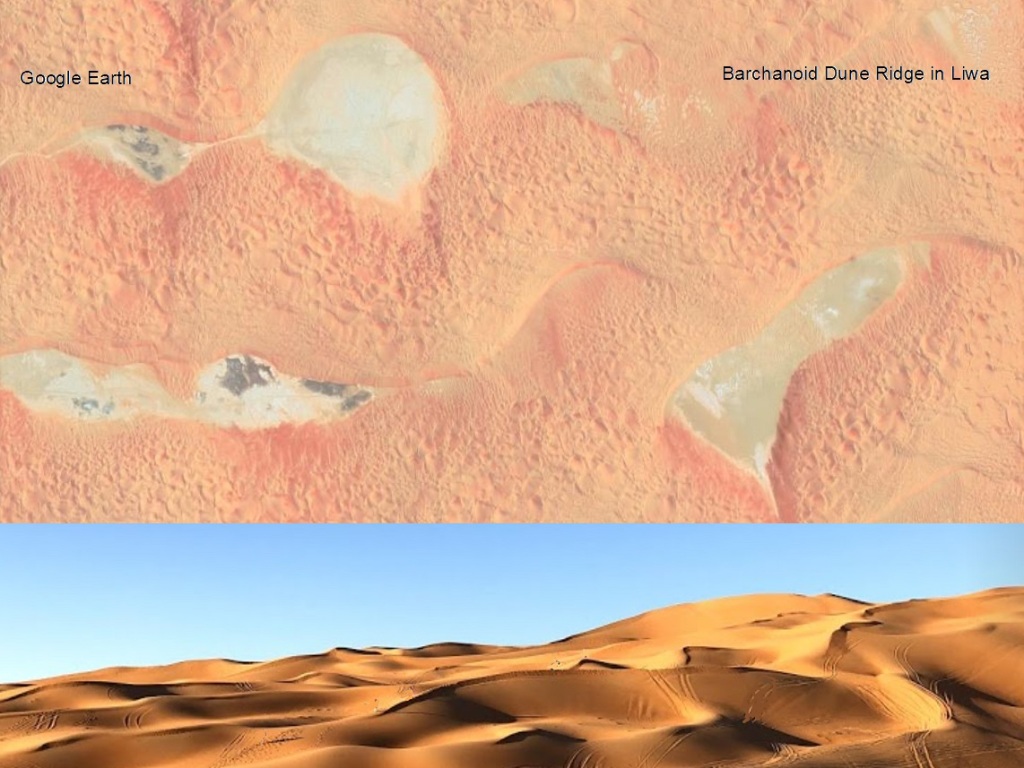
Barchanoid ridges
Barchans and megabarchans can be combined laterally to form barchanoid ridges. These are especially common in Liwa area in the southern UAE (United Arab Emirates), with at least 70 dune ridges.
星型砂丘
Star dunes
孤独な砂山砂丘は、主に星型砂丘とドーム型砂丘です。星型砂丘は砂丘が比較的安定するまで風が様々な方向から作り出すいくつかの砂丘の尾根の収束によって形成されます。その中でも高さが100~200メートルを超える大きなものはアーホードもピラミッド砂丘とも呼ばれ、目を引く存在です。
ピラミッド型の砂丘は、主に南東部のルブア・ハーリー沙漠の内部ドファールに隣接する部分に沿って見られます。 それらは、2つ以上のS字状の尾根の収束によって形成され、比較的安定した後、漂流する砂の堆積によって成長するように見えます。それが 「コンパスの周りを風が吹くと、シグモイド砂丘からピラミッド型砂丘が形成される」と言われる所以です。これらの大きな砂丘は、しばしば砂山と呼ばれ、直径0.5〜2 キロで、高さ150メートルに達します。 ルブア・ハーリー沙漠南東部では、ラムラト・ファサド(رملة فسد)に見られるように個々のピラミッド型の砂丘が一列に並んでいることがわかります。
ドファール内部では、これらの砂丘は、南または南東から内陸に吹く風によって生成され、風下側は常に北にあります。そしてルブア・ハーリー沙漠南部の一般的な風の循環の一部である北東の風によって整列されています。孤立した砂丘の山塊、またはqa’aidは、ルブア・ハーリー沙漠南東部のガニーム・サンドで知られています。
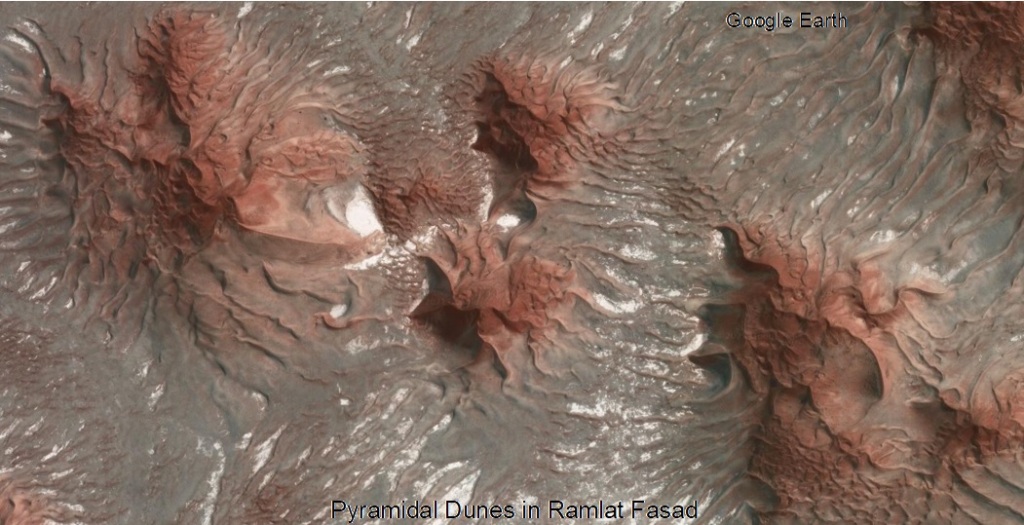
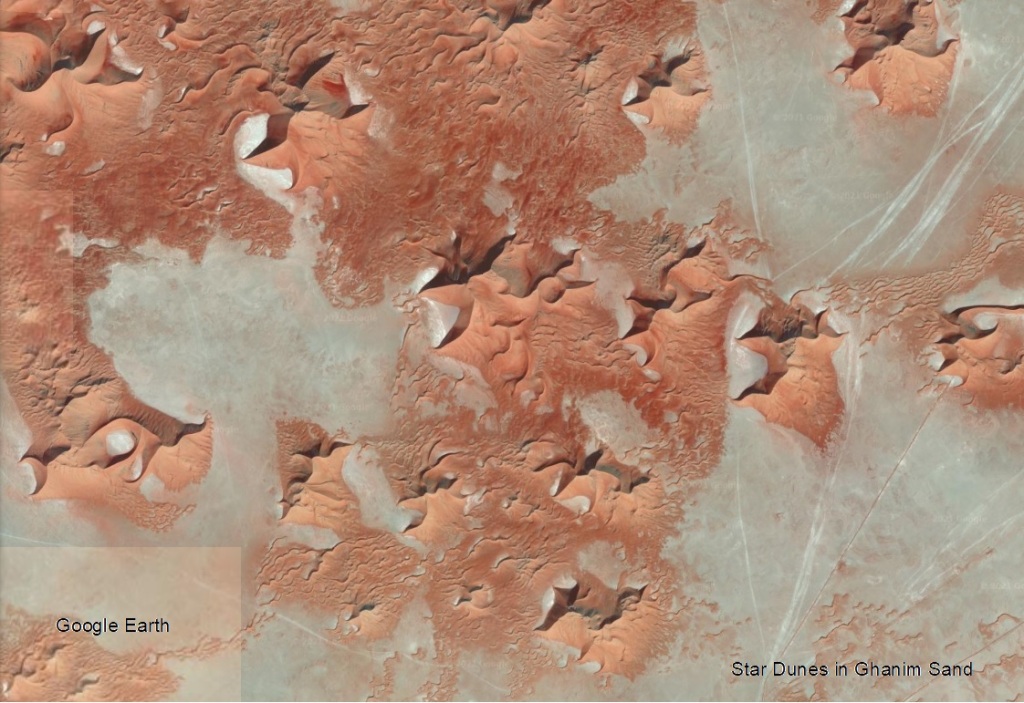
Lonely isolated sand mountains are mainly star dunes and dome dunes. Star-shaped dunes are formed by convergence of several dune ridges that winds create from different directions until dunes are relatively stable. Among them, large ones with a height of over 100 to 200 meters are eye-catching and are called rhourd and/or pyramidal dunes.
Pyramidal dunes can be found mainly along the southeastern Rub’ al Khali adjacent to inner Dhofar in Oman. They are formed by convergence of two or more S-shaped ridges and appear to grow by deposits of drifting sand after being relatively stable. That is why it is said that “when wind blows around a compass, pyramidal dunes are formed from sigmoidal dunes”. These large dunes, often referred to as sand mountains, are 0.5-2 kilometers in diameter and reach a height of over 150 meters. In the southeastern Rub ’al Khali, pyramidal dunes line up in linear belts, as seen in the Ramlat Fasad.
Inside Dhofar, these dunes are created by inland winds from south or southeast, with leeward side always north. And it is aligned by northeastern winds, which are part of the general wind circulation in the southern Rub’ al Khali. An isolated dune massif, or qa’aid, exist in the Ghanim Sand in the southeastern Rub’ al Khali.
ドーム型砂丘
Dome dunes
もう一つの孤独な砂丘がドーム型砂丘です。直径2キロ、高さ60〜100 メートルの大きな円形または楕円形のドーム型砂体(円錐台あるいは楕円錐台)からなるドーム砂丘は、特にハドラマウトアーチ北部に隣接するルブア・ハーリー沙漠中央部西の南縁部に並ぶムラト・ウム・ガリブとラムラト・ハザールで発生しています。 これらのドーム砂丘は、局所的にランダムに変化する風のパターンと組み合わされた比較的制限された砂の供給によるものと思われます。その形から涙型砂丘と呼ばれることもあります。このタイプの砂丘は、ルブア・ハーリー砂沙漠のごく一部を占めているにすぎません。
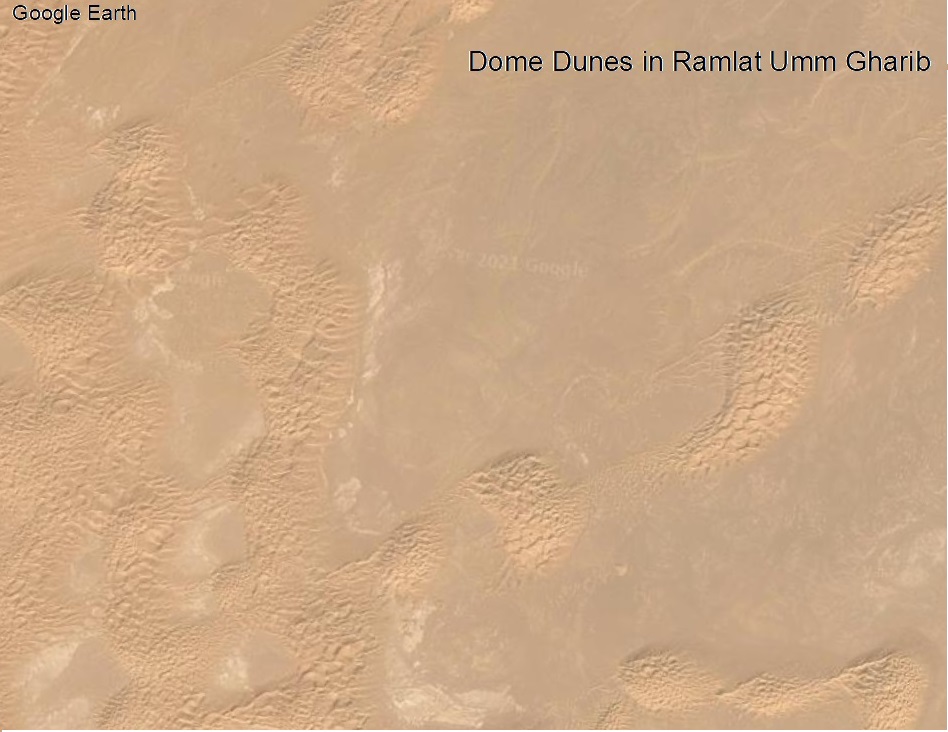
Another lonely dunes are dome dunes. Large circular mounds or oval mounds with a diameter of 2 kilometers and a height of 60-100 meters occur especially in the Ramlat umm Gharib and the Ramlat Hazar, which line southern edge of the central western Rub’ al Khali. Those locations are adjacent to the northern Hadramawt arch. These dome dunes are formed due to a relatively limited supply of sand combined with randomly changing local wind patterns. Because of their shapes, they are called tear-drop dunes, sometimes. This type of dune occupies only a small part of entire sand dunes of the Rub’ al Khali.
